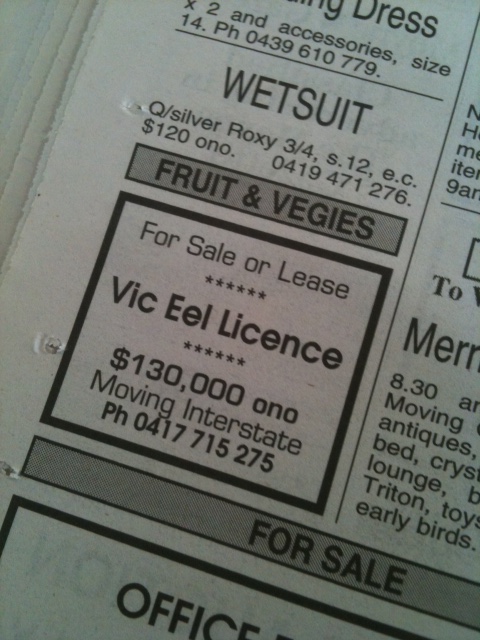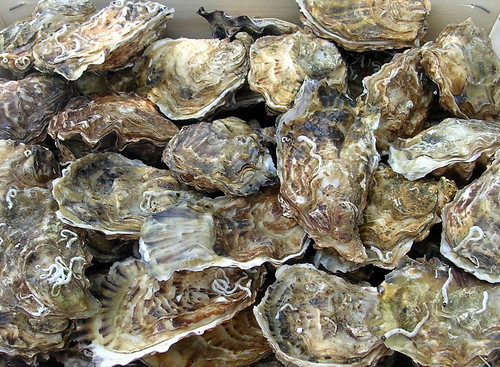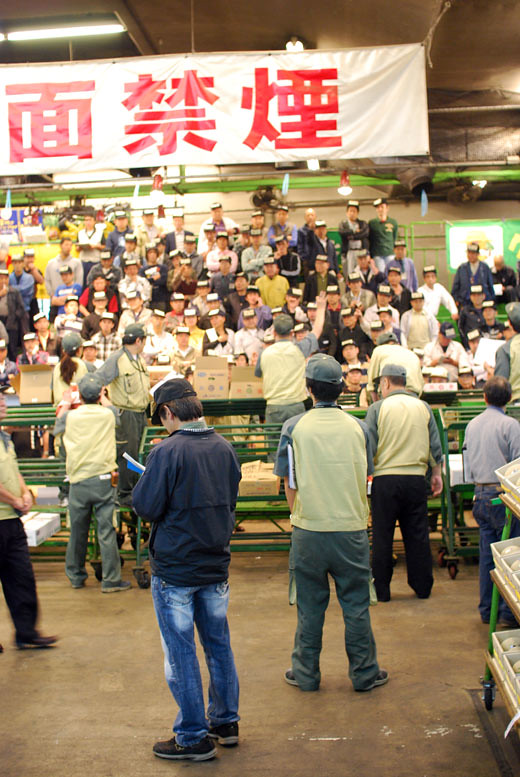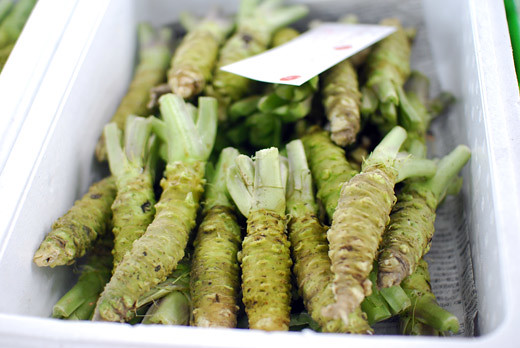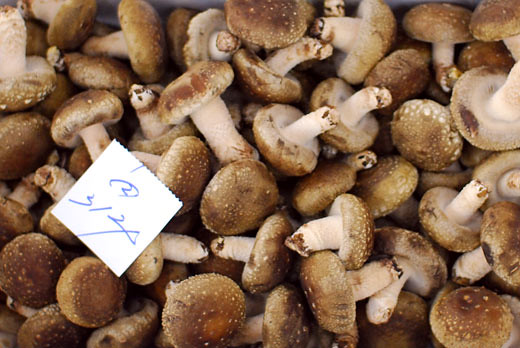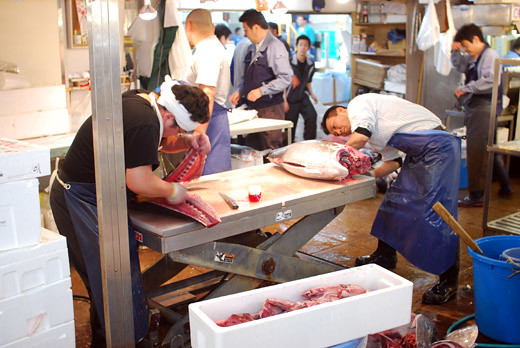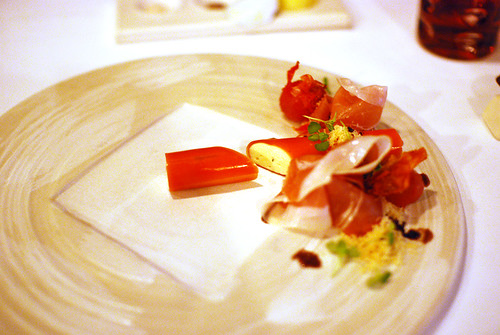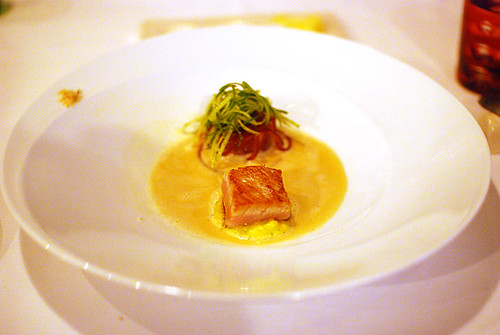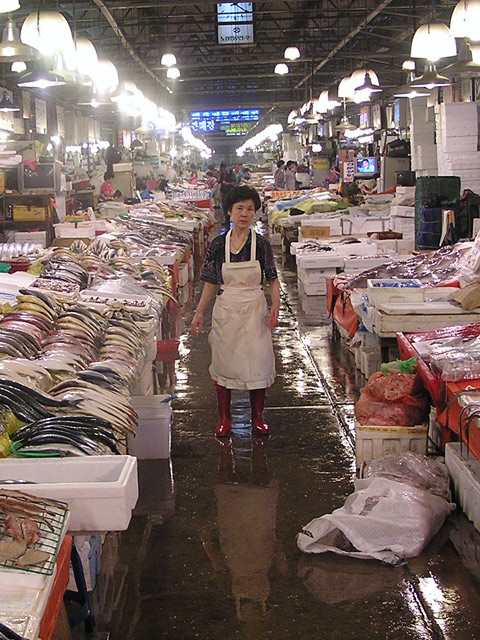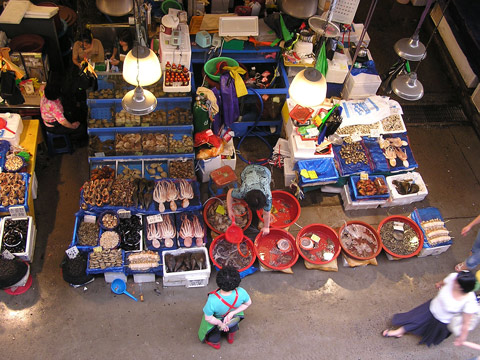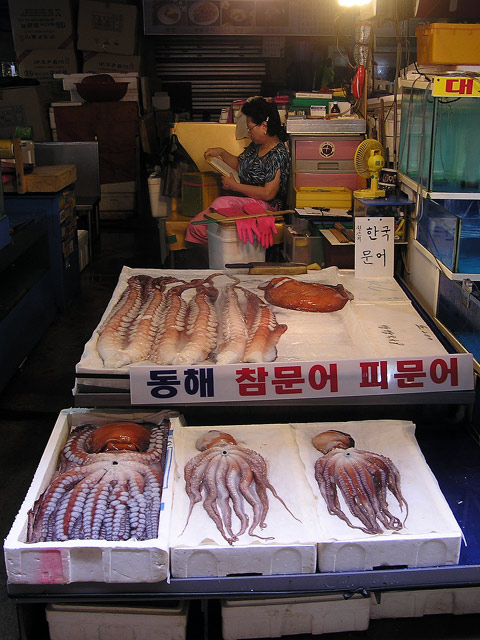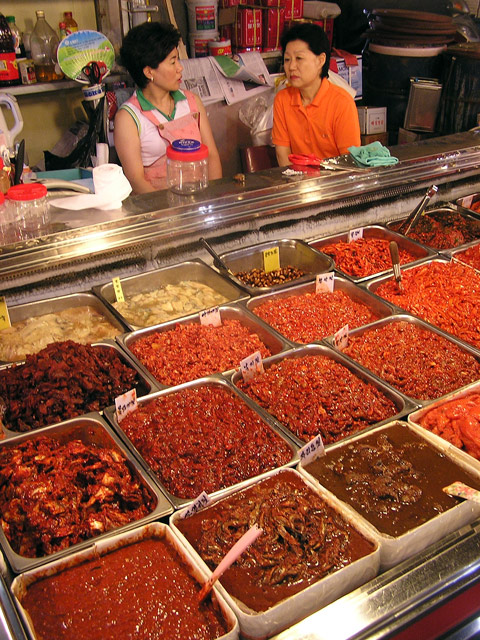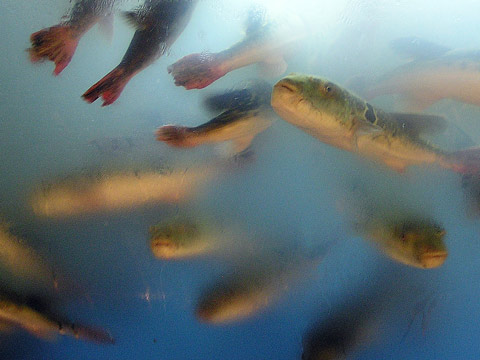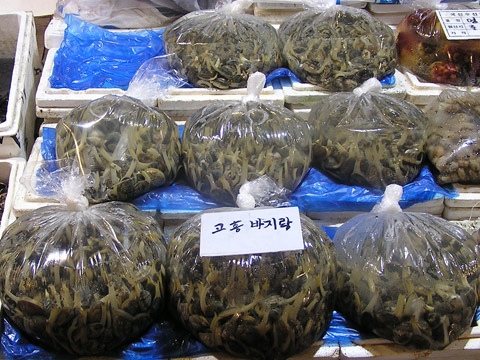Also, eel is a vegetable.
Posts Tagged → fish
Oysters are functionally extinct
Enjoy those wild oysters while you still can: just in from the American Institute of Biological Sciences,
The overall condition of native oyster reefs is poor in most of the 144 bays in 40 ecoregions we evaluated. Although individual oysters are still present in most places, records of historical (past 20 to approximately 130 years) and recent abundances show that many reefs that were once common are now rare or extinct as ecosystems. Oyster reefs are at less than 10% of their prior abundance in most bays (70%) and ecoregions (63%). They are functionally extinct—in that they lack any significant ecosystem role and remain at less than 1% of prior abundances in many bays (37%) and ecoregions (28%)—particularly in North America, Australia, and Europe. Very few bays and ecoregions are rated as being in good condition (> 50% of reefs remaining). Our results most likely underestimate losses because of the lack of historical abundance records, which particularly affects assessments in South America, temperate Asia, and South Africa.
They go on to say that their estimates are conservative. The report also manages a shout out to Georges Bay, Tasmania, the last home of wild ostrea angasi, which was recently opened for harvesting.
Tsukiji Market is not just fish.
It also sells fat red chunks of whale meat. Not much of it though.
While the cubed cetacean is pretty hard to uncover (I only saw a single vendor), what does tend to get overlooked is that there is also a gigantic vegetable market next door. Compared to the speed and clatter of the neighbouring fish market, the vegetable sheds are downright sedate. Fewer forklifts and a general lack of food voyeurs striding amongst the hundreds of low rows of boxed vegetables than on the fish side.
The auctioning takes place on a set of bleachers in the middle of the warehouse, boxed vegetables opened in front of the crowd and quickly sold off.
A box of fresh wasabi root. The general quality on show is overwhelming (not that I’m a great pick of wasabi in particular) – but there does seem to be a clear reason for the premiums paid on vegies in Japan.
This is where tuna ends
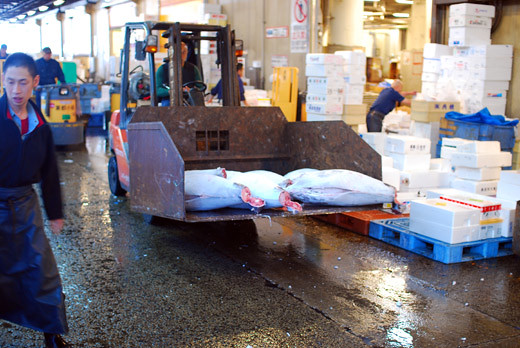
Whole frozen tuna on a forklift at Tsukiji fish market, Tokyo
I have no hope whatsoever for the future of tuna. The death warrant for Atlantic tuna was written at the last meeting of the International Commission for the Conservation of Atlantic Tunas, ensuring that current tuna stocks will have a 50% chance of recovering in the next decade. The tuna is one of the only endangered species that you could buy at the supermarket to feed to your cat or rave about eating a perfect red shard atop vinegared rice without social repercussions. I doubt this prevailing attitude will change before the bluefin and yellowfin tuna are well dead.
Roughly, three quarters of the world’s tuna is eaten by Japan and from four in the morning, it looks like roughly three quarters of the Japan’s tuna is at Tsukiji fish market in downtown Tokyo. Frozen torpedoes of fish are lined up in a warehouse for auction, a visual cliche of Tokyo that wrestles for space in travel brochures with Goth Lolitas and that busy intersection in Shibuya.
The auction rooms are currently cut off to tourists thanks to its popularity and the propensity of tourists to fall beneath forklifts. (It appears that the auction area is actually open to a limited number of visitors each day (Cheers, Akila) – I must have missed the cut). Austin Bush has some excellent coverage of the auctions. I concentrated on what happens next.
The areas where the middlemen transfer and dismantle the tuna is still accessible for death by forklift. Tuna are transferred from the auction area into stalls on handcarts yoked to the elderly, motorised gurneys which appear to be the offspring of a motorcycle and a double bed, and your construction-variety forklift.
Tuna are kept cool with blocks of dry ice while they await the bandsaw. The smaller stallholders break down their morning’s buy into component cuts, dividing the buttery belly cuts from the coarser red flesh. It’s a much less sterile process that I would have expected with tuna heads piling up on the concrete floor before the flesh is removed from their cheeks, collar and eyes.
Fresh fish are hand-filleted. If you’re at all interested in the full Japanese 27-step process for breaking down a tuna, Cooking Issues comes up with the goods.
Once removed from the bone, fillets are further onsold; restaurants and smaller vendors picking up particular cuts to resell elsewhere in the city and sate the endless appetite for this doomed fish.
Future of Fish in the NYT

It’s taking me a while to catch up on my reading at the moment, but Mark Bittman’s overview of the decline of fish is worth a look. From Bittman:
Industrial aquaculture — sometimes called the blue revolution — is following the same pattern as land-based agriculture. Edible food is being used to grow animals rather than nourish people.
This is not to say that all aquaculture is bad. China alone accounts for an estimated 70 percent of the world’s aquaculture — where it is small in scale, focuses on herbivorous fish and is not only sustainable but environmentally sound. “Throughout Asia, there are hundreds of thousands of small farmers making a living by farming fish,” said Barry Costa-Pierce, professor of fisheries at University of Rhode Island.
But industrial fish farming is a different story. The industry spends an estimated $1 billion a year on veterinary products; degrades the land (shrimp farming destroys mangroves, for example, a key protector from typhoons); pollutes local waters (according to a recent report by the Worldwatch Institute, a salmon farm with 200,000 fish releases nutrients and fecal matter roughly equivalent to as many as 60,000 people); and imperils wild populations that come in contact with farmed salmon.
Originally, Last Appetite was going to be about the collapse of fish. Maybe I should revisit that when the fish stocks that have already collapsed hit 50%. Which is possibly now.
Vue De Monde, Melbourne
When Dickens’ Ghost of Christmas Future Yet Come decides to take me out to dinner, he’d probably take me to Vue De Monde to wallow amongst the Baby Boomer dugongs in suits and pearls. That crystalline vision into how my life would transpire if I spent the next twenty odd years focusing upon crapulence would scare me much more than a pauper’s grave.
It did scare me.
This is no fault of Shannon Bennett’s, the oft lauded chef behind the restaurant frequently name-dropped as the best restaurant in Australia.
The only thing that Bennett has left lacking from Vue de Monde is a sense of pomposity. If you were fresh from doing the rounds of France’s most ostentatious eateries I’m not sure whether this would delight or disappoint. The room at Normanby Chambers in Little Collins St, Melbourne is lit with bare strings of oversized, chromed bulbs, the focus of the entire room being upon the open kitchen with mirror above the staff doing the plating. The architectural message is that you’re there for the food and for the front-of-house theatrics that accompany it.
(The Laguiole silverware is a little pompous but much like a Hard Rock Café, it is available for purchase in the gift shop. The fish fork would be a handy piece of equipment for aerating compost.)
It isn’t the level of service that sets apart Vue de Monde but its distinctiveness. It is not a slavish attentiveness that is confused for service at many a fine dining establishment but the ability of staff to have some agency in their roles. If I was making a bad decision in choosing a wine or dish or attempting to customise something to meet my foolish caprices, I get the feeling that Vue De Monde’s crew would tell me that I’m making a grave mistake in no uncertain terms rather than an obsequious “has Sir considered the…”-type suggestion.
The egalitarian service is the most Australian element of the whole experience but does rest upon retaining and training the best of staff, the people that you can rely upon to chat comfortably about how a thermomixer works or the technique used to turn parmesan into a rough sand. Delicious, delicious sand. There is no menu; you submit yourself to the whims of those service staff. They can be steered in a particular direction but the absolute and final control over your food is out of your hands. They chose:
Amuse bouche: A single cos lettuce leaf containing a smear of jamon paste and a sous-vide quail egg balanced atop a wine glass half filled with silky ham consommé and pea foam.
Salmon attacked from all sides: smoked, sliced, jerked, creamed; some sort of dried fish foam (salted cod, perchance?) and a frankly superfluous layer of gelatinized something. There is caviar and micro-herbage. Cubes of fried sourdough on each end.
Mushrooms: tubes of liquified Swiss Brown (?), slightly gummy and al dente on the outside but squirting silky shroom juice from within; with pan-fried shimeji (?) and slices of eringi(?); tarragon emulsion. My mushroom identification skills would kill me in an unforgiving forest.
Gel cannelloni with powdered parmesan cheese and olives; two perfectly ripe cherry tomatoes topped with their own dried skin; some respectable Serrano ham. Where the hell do you get a tomato this impeccable and ripe in winter? I love technique; the mix of industrialisation of food (gel) with small-producer artisanship (ham). It also seems to look like an in-joke about hot dogs, to which I am obviously not averse.
Foie gras, frozen in liquid nitrogen then powdered in a thermomixer, served cold with a dash of “Thai” curry sauce (poured at the table) and three flawless nasturtium leaves. I wish that I could get dispensation for punching people every time that they call a curry “Thai” because it contains coconut milk. But the foie gras, melting on the tongue, is awe-inspiring and smooth like chocolate.
Cold shot of verjus with hibiscus tea, served in a martini glass.
A dainty square of toro on a perfect corn puree; tuna ceviche topped with glass noodles soaked in a lightish soy, shredded fennel(?) and something else green. All surrounded by tuna bone stock and butter. A microdot of sesame salt on the side. By this point my palate is pretty much shot from all the permutations of fat.
Hare: two slices of hare loin on pureed, roasted garlic; a gamy hare jelly; yeast foam; a sourdough lattice. More microherbs.
We skipped out on dessert. I would possibly have burst an internal part. My stomach is still not well trained back into ingesting huge quantities of high fat, Western food. I walked out feeling like somebody had inflated a balloon full of rich creamery butter within me. I’m still recovering.
Probably the only complaint that I could muster was the umami-ness of nigh on everything; all playing on the centre and back of the palate rather than forcing anything to the edges of sour, astringent or bitter. I could have probably specified against this in advance. I’m sure that if you’re a much bigger aficionado of French cuisine, you’d pointy out that I’m missing much of the subtlety but the effect of having so much umami does feel like the chefs aren’t painting from the full palette available to them.
Price: we ate and drank at roughly the speed of $1 per minute per person, for three hours. You do the math.
Location: Vue de Monde, 430 Little Collins Street, Melbourne, Australia
Phone: +61 3 9691 3888.
Noryangjin Fish Market, Seoul
Whenever people describe fish markets, they highlight the predawn chaos and the movement and flow of fish as the only ordered element amongst the pandemonium. I’ve been guilty of it myself. At three o’clock in the afternoon, Noryangjin Fish Market in Seoul is a bastion of calm. The morning crowds have dispersed along with their creels of seafood but the remaining catch appears as fresh (or in many cases, as alive) as it was hours earlier. The occasional browser wanders amongst the aisles of assorted sea creatures in a noncommittal manner; vendors discuss their day, eat a late lunch and share bottles of soju; some prepare for the smallish after work crowd to pick over their remaining wares. There is no compulsion for the hard sell at this time of the day and commerce seems secondary.
Along the Noryangjin Station side of the market is a raised walkway offering birds-eye views of the fishy tableau, along which nestles a line of Japanese and Korean restaurants that capitalise on their proximity to seafood.
Closest to the walkway on the floor of the market seems to house the greatest concentration of live seafood: crabs, fish, shellfish, octopus and other horrors from the Deep.
Octopus come in all dimensions, ranging from thumb-sized to those capable of battling Neptune for undersea supremacy (above).
On the far side of the market from the station, vendors specialise in Korean fish and shrimp pastes in varying degrees of degradation. The focus seems to be on chilli-hot pastes rather than unadulterated salty rotting fish.
The aisles of market stay damp from the melting ice, frequent hosing down and the slosh of fish in tanks. The above pufferfish were more subdued, but were the first that I’ve seen on sale for the purposes of eating, ever.
Shellfish abound in phenomenal variety with bags of clams packed with seawater to keep them alive.
Location: Opposite Noryanjin Station in Seoul, accessible via the raised walkway from the train station.
